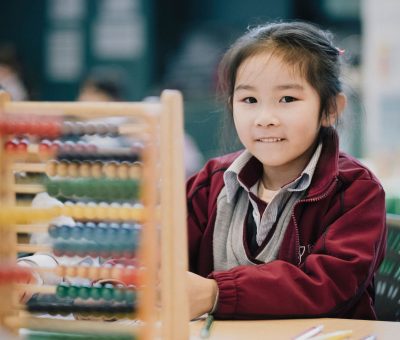We provide personalised learning so that all students have opportunities to experience growth and progress in Mathematics.
At Trinity School, we embrace Melbourne University’s Clinical Teaching Cycle where teachers assess the students learning, plan and personalise the learning according to the pre-assessment, explicitly teach students at their point of need, evaluate the students learning, reflect on teaching practice and the effectiveness of their teaching, and assess student growth and progress.

Students are actively engaged in one hour of Mathematics each day. During this time students are involved in learning activities at their point of need, and skills are explicitly taught in Number and Algebra, Measurement and Geometry, and Statistics and Probability, as outlined in the Victorian Curriculum. The children at Trinity Catholic School have opportunities to learn in a variety of ways – in small targeted focus groups, whole class learning, or one to one instruction with the classroom teacher or learning support officer, as needed. Teachers monitor students learning in an ongoing way and this formative assessment enables teachers to plan for future learning. Students participate in a pre and post test for each new topic in mathematics so that teachers can monitor growth and progress and plan for students individual learning needs.
Learning Sprints is a process we adopt across the school in Numeracy, which enables teachers to target student learning needs and strives to improve teacher practice. Students are given ongoing feedback about their learning.
At Trinity Primary School we use a variety of resources and a variety of assessment tools to plan for teaching and learning and the teachers are involved in ongoing professional learning so that they are up to date with current research and best practice in the teaching of numeracy.
Digital technologies, in particular coding, are embedded throughout the numeracy learning activities as outlined in the Victorian Curriculum.
Home learning activities relate to the current learning in the classroom related to Number and Algebra, Measurement and Geometry, and Statistics and Probability. All parents have access to Google Classroom and Seesaw to be able to access student learning in numeracy.
The students at Trinity also have the opportunity to be involved and engaged in a variety of Mathematical experiences throughout the year.
This can occur:
Our Mathematics curriculum encourage students to become self-motivated, confident learners through inquiry and active participation in challenging and engaging experiences. For those students who are struggling we also support them.
Trinity Primary School is focussed on ensuring that all students achieve growth in Mathematics. For those students who are experiencing difficulty.
Intervention occurs